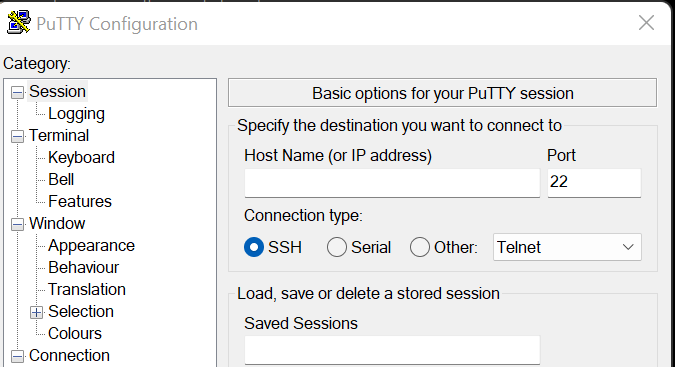Reading Time: 4 minutes
How to login to Linux Or Unix System. This article will guide you on How to login to Linux Or Unix System. Learn to effortlessly log into Linux or Unix systems using Putty or the Terminal. This quick guide provides step-by-step instructions, ensuring a seamless login process. Whether on Windows or Mac, empower yourself to navigate and manage your system with ease.
Table of Contents
Introduction:
Unlock the secrets of efficient Linux and Unix system access with our comprehensive guide. Whether you’re using Putty on Windows or Terminal on Mac, this step-by-step tutorial ensures a seamless login experience. From essential requirements to validation commands, empower yourself to effortlessly navigate and manage your systems.
Requirements:
- Essential tools: Putty, Super Putty, or alternatives
- Server details: IP/FQDN, username, SSH password
- Guide to installing Putty on Windows
If you have not installed Putty yet & have not configured it, Please follow the tutorial “How to install Putty“
How to login to Linux Or Unix System
How to Login Using Putty :
- Open Putty:
- Launch Putty on your Windows computer.
- Enter Host Name or IP:
- Input the server’s IP address or FQDN in the designated field.
- Select Port 22:
- Ensure the port is set to 22, the default for ssh connections.
- Click on “Open”:
- Initiate the connection by clicking the “Open” button.
- Enter User Name:
- Input the username associated with the server.
- Enter Password:
- Provide the corresponding password when prompted.
Open Putty Enter Host Name or IP Select Port 22 Click on "Open" Enter User Name Enter Password
I have covered these complete steps on Youtube


MAC Users can directly open ” Terminal “and use the below command.
ssh username@server-name- Enter Password
You should be able to log in to Linux, and Unix Servers.
- You can validate if are able to login successfully
- Execute $ id command
- Example: adminuser@testertechie:~$ id
uid=1001(adminuser) gid=1002(adminuser) groups=1002(adminuser)
adminuser@testertechie:~$
- Example: adminuser@testertechie:~$ id
- You can also execute $ uname -a command to validate you have logged into the correct host.
- adminuser@testertechie:~$ uname -a
Linux testertechie 5.15.0-56-generic #62-Ubuntu SMP Tue Nov 22 19:54:14 UTC 2022 x86_64 x86_64 x86_64 GNU/Linux
adminuser@testertechie:~$
- adminuser@testertechie:~$ uname -a
Note: The system prompt you are presented with. On our system, the prompt is adminuser@testertechie:~$.
The first part of the system prompts up to the @ symbol is the user name that is currently logged in. In our case the user name is adminuser. The second value after the @ symbol and before the: is the host’s name. This host’s name is testertechie.
Conclusion
Congratulations, you’re now adept at logging into Linux or Unix systems, mastering both Putty and Terminal for seamless system access.
Q: How can I log in to a Linux or Unix system using Putty or Terminal?
A: Mastering Linux/Unix Login: A Scannable Guide
-
Q: What tools do I need to log in?
- A: For Putty on Windows, ensure ssh tools and server details. Mac users can use Terminal with the command
ssh username@server-name.
- A: For Putty on Windows, ensure ssh tools and server details. Mac users can use Terminal with the command
-
Q: How do I log in using Putty?
- A: Open Putty, enter server details, select port 22, click “Open,” input username, and enter the password when prompted.
-
Q: Any specific instructions for Mac users?
- A: Mac users can directly use the Terminal with the command
ssh username@server-nameand enter the password.
- A: Mac users can directly use the Terminal with the command
-
Q: How can I validate a successful login?
- A: Execute commands like
$ idand$ uname -ato verify the login details and host information.
- A: Execute commands like
-
Q: What’s the significance of the system prompt?
- A: The system prompt displays the current user and host name, providing essential information post-login.
-
Q: What is Putty?
- A: Putty is a free and open-source terminal emulator, serial console, and network file transfer application. It supports various network protocols, including SSH, Telnet, and Rlogin, making it a widely used tool for secure remote access to Linux and Unix systems.
-
Q: What features does Putty offer?
- A: Putty provides a simple, lightweight interface for connecting to remote servers. It supports SSH key authentication, configurable session settings, and facilitates secure command-line access to servers.
-
Q: Is Putty only for Windows users?
- A: While originally designed for Windows, Putty has become popular and is widely used on other platforms. Windows users benefit from its graphical interface, while alternatives like Terminal on macOS and Linux offer similar functionality.
-
Q: Can Putty be used for tasks other than remote access?
- A: Yes, Putty is versatile and supports various use cases, including serial communication, network file transfers using protocols like SCP and SFTP, and acting as a secure proxy.
-
Q: How can I obtain Putty?
- A: Putty can be easily downloaded and installed for Windows from its official website. Users on other platforms may explore alternative terminal emulators or use built-in tools like Terminal on macOS and Linux.
Follow us on Facebook Twitter X Reddit Quora Linkedin Tubmblr Youtube
